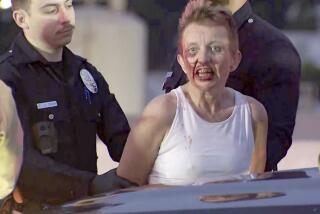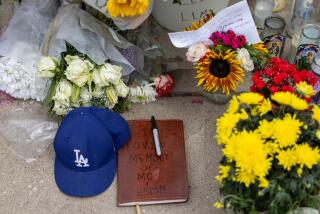Driver in Paris Crash Reportedly Legally Drunk
PARIS — The man driving the limousine in which Princess Diana was killed was legally drunk, with more than three times the lawful level of alcohol in his blood as he raced through central Paris at speeds of more than 110 miles an hour, official French sources said Monday.
Two New York tourists, meanwhile, came forward to paint a grisly, ghoulish tableau of the scene of Diana’s fatal accident, with photographers crowding within inches of the dying, moaning princess and other bloodied victims to snap their pictures and shoving aside police who tried to keep them at a distance.
Authorities indicated at least some of the seven photographers who had been chasing Diana on motorcycles and were detained after the accident could be charged with violating France’s “Good Samaritan” law requiring people to help others in distress.
Diana, 36, was mortally injured in the high-speed crash of the black Mercedes-Benz sedan early Sunday, while her wealthy companion, Dodi Fayed, 41, and the driver, Hotel Ritz employee Henri Paul, were killed on the spot.
The car hit a concrete pillar in an underground road tunnel running parallel to the River Seine. Police detectives from the Paris Criminal Brigade, heading the investigation into the tragedy, estimated Monday that the vehicle was traveling at least 111 mph in a 30-mph zone when it crashed.
Confirming earlier reports, co-workers at the Ritz said the limousine’s driver was not a full-time chauffeur but a former French serviceman who was deputy chief for security at the exclusive establishment owned by Fayed’s father, Egyptian tycoon Mohammed Fayed. Paul, 41, sometimes chauffeured VIP guests at the hotel, they said.
Late Saturday, in an effort to elude the photographers that went tragically awry, the security specialist was pressed into service to drive Diana and her suitor. There were unconfirmed reports in British newspapers early today that there had been taunting between Paul and the photographers, with the driver telling them they would never catch him.
Michael Cole, spokesman for the Fayed family, said in London that Paul, “an exemplary employee” who had picked up the couple at the airport and brought them into Paris earlier in the day, had been the third choice to drive the couple from the Ritz after dinner.
The first driver and a backup were surrounded by photographers as they arrived in front of the hotel. In Paris, Bernard Dartevelle, a lawyer for the elder Fayed, said the regular chauffeur tried to trick the photographers into following him.
Paul then left with Diana and the younger Fayed from the rear of the hotel, according to Cole, but was detected by the paparazzi. One of the photographers’ motorbikes, Cole claimed, tried to cut in front of the limousine to slow it down.
“The photographers were flashing off blitz lights into the eyes of the people inside the car,” Cole said. “It was like a stagecoach surrounded by Indians, but instead of firing arrows, they were firing these lights into the eyes of the people.”
Employees at the Ritz, where Paul, identified by one hotel official as a former commando in the French air force, had worked since 1986, expressed puzzlement that he then lost control of the vehicle.
*
Far from being an inexperienced driver, Cole said, Paul, a native of the port city of Lorient in Brittany, had taken two driving courses on how to chauffeur bulletproof and conventional limousines at a school run by Mercedes near Stuttgart, Germany. Paul had also learned anti-terrorist and anti-hijacking techniques.
But Monday afternoon, French law enforcement sources dropped a bombshell by leaking the results of a post-mortem examination that found 1.75 grams of alcohol per liter in Paul’s blood--more than three times the legal limit here.
Although the U.S. alcohol blood-level measures are expressed differently from those in France, the numbers are directly proportional. For instance, the legal level of intoxication for driving in the state of California is 0.08%--which is 80 milligrams of alcohol per 100 milliliters of blood. The reported amounts of alcohol in Paul’s blood would be expressed in American terms as his having a .175% blood alcohol level.
Terrance Schiavone, president of the National Commission Against Drunk Driving in Washington, estimated that it would take a 160-pound man “between eight and nine drinks in one hour on an empty stomach” to reach that level of intoxication. And for every hour that passes, a motorist loses the effect of one drink. “If he’s drinking from maybe 7 p.m. to midnight--and presumably he’s eating--to maintain that level at that late hour [of the crash], that’s just an enormous amount of alcohol,” Schiavone said. “I think the whole thing goes to show his whole sense of judgment was impaired.”
In London, a spokesman for the Royal Automobile Club said the reported alcohol level, the equivalent of drinking more than a bottle of wine, would “severely impair a driver’s ability to judge and control a vehicle.” By inducing a lower level of anxiety, the alcohol might also tempt the driver to take risks, RAC spokesman Richard Wood said.
There were conflicting reports as to whether the sedan was armored. But Griffith Edwards, a University of London specialist on alcohol addiction, told Britain’s Sky News that driving the heavier, armored model car with “that amount of alcohol would be lethal . . . you’re inviting death.”
*
Diana’s fairy tale life, then, may in the end have been cut short by an all too familiar and deadly combination in France: drinking and speed.
Although France has one of the toughest drunk-driving laws in Europe, alcohol is directly blamed for an average of 3,600 deaths per year on French roads, and is a factor in 40% of all traffic fatalities, official statistics show.
According to witnesses interviewed by the Paris daily Le Monde, the Mercedes 280 SE carrying Diana and her suitor in the back seat streaked at high speed down a straightaway on the Seine’s Right Bank, then arrived at the entrance to the tunnel by the Pont de l’Alma, a bridge spanning the river.
It was then that Paul tried to maneuver to avoid running into another vehicle obeying the speed limit, Le Monde reported. One witness, Gary Dean, 38, told another French newspaper, Le Parisien, that the car was going about 90 mph, and “I thought it would never make it through the tunnel at such a rate.”
Police investigators found skid marks just before the first point of impact, indicating Paul tried to brake. Accident experts, using photographs of the wrecked Mercedes to construct a computerized simulation of the accident, and comparing results to pictures from crash tests, estimated the car struck the post at 112 to 121 mph. After the wreck, its speedometer was frozen at 196 kilometers an hour--the equivalent of 121 mph.
One early hypothesis had been that the pursuing photographers might somehow have caused the wreck by forcing Paul to veer. Despite the accusations renewed by the Fayed family’s spokesman on Monday, interviews with witnesses now lead Paris police to believe that the photographers, mounted on motorcycles and scooters, were 100 yards distant when the car crashed.
But Dartevelle, attorney for the senior Fayed, claimed that even if Paul was drunk, it didn’t reduce the responsibility of the celebrity-chasing paparazzi. “If the photographers had not organized the race in pursuit, it is highly probable that the chauffeur would not have driven at an excessive speed,” Dartevelle said.
The tragic circumstances of Diana’s death have led to often-angry demands for restrictions on the activities of star-stalking photographers and sudden and intense scrutiny of the publications they work for.
According to Le Monde, witnesses said some photographers pushed would-be rescuers aside after Diana’s accident so they would have a clear view of the bleeding victims. Photographers also argued with the first two police officers on the scene that they be allowed to “do their work,” Le Monde said.
Jack and Robin Firestone, a couple visiting Paris from New York, were so disgusted by what they saw in the roadway under the Place de l’Alma that they contacted Agence France-Presse, the French news agency.
“We wanted to testify, because really, the behavior of the photographers was shocking,” AFP quoted Robin Firestone as saying. “They placed the lenses a few centimeters from the bodies and pushed away the two policemen who were trying to get them away.” She told AFP that, not yet realizing who was in the wreckage, “We only saw the body of a blond woman sticking out of the smashed windshield, her head was turned to the side, it was awful.”
But a source close to the investigation said Monday that one of the photographers had used his portable telephone to summon help. Dr. Frederic Malliez, a physician who was one of the first helpers on the scene, and who said he tried to assist the moaning Diana by lifting up her head and placing an oxygen mask on her face, said the “10 to 15 photographers” busily at work didn’t interfere with him.
The seven photographers detained for questioning were being grilled at police headquarters near Notre Dame Cathedral in central Paris, and will be kept in detention overnight Monday, sources said. Police have not named any of these individuals.
But they included, Le Monde said, news photographers Jacques Langevin of the Sygma photo agency, Nicolas Arsov of Sipa, two photographers from Gamma and photographers working for the Angelli and Stills agencies that specialize in trailing celebrities.
Another French newspaper, without providing names, said some of the detained photographers had covered the Gulf War and other major news events.
A fourth occupant of the Mercedes, bodyguard Trevor Rees-Jones, was the only survivor of the accident and the only person in the car believed to have been wearing a seat belt. Rees-Jones was sitting in the front passenger seat.
The Paris prosecutor’s office said the bodyguard, who was in intensive care Monday, should be able to shed more light on exactly what happened but was still in too critical a condition to be questioned.
Times staff writers William D. Montalbano in London and Carla Hall in Los Angeles contributed to this report.
* AL MARTINEZ
A father’s words to his daughter explain it best: There are no fairy tales anymore. B2
(BEGIN TEXT OF INFOBOX / INFOGRAPHIC)
Scene of the Crash
Princess Diana, Dodi Fayed and a driver were killed when their automobile crashed while in high-speed flight from paparazzi .
What Happened
12:05 a.m.: The couple, accompanied by a bodyguard an a Hotel Ritz security guard acting as a driver, leave the hotel, pursued by paparazzi on motorcycles.
12:20 or soon afterward: Traveling at high speed, the car is midway in the Pont de l’Ama underpass when the driver loses control, crashing into a support pillar. Fayed and the driver are pronounced dead at the scene.
12:27 a.m.: Paris Fire Brigade gets first call alerting authorities to accident.
1. The princess’ car strikes a mid-tunnel cement pylon.
2. It crosses lanes, hitting the opposite wall.
The Car
The car weighs two tons, sells for around $66,000 and is the top of the Mercedes line, with an engine capable of top speeds of 133 mph. It is ranked among the world’s safest cars. There was conflicting information as to whether this vehicle was specially armored. When the car was found, the speedometer was frozen at 196 kilometers per hour (121 mph).
More to Read
Sign up for Essential California
The most important California stories and recommendations in your inbox every morning.
You may occasionally receive promotional content from the Los Angeles Times.










